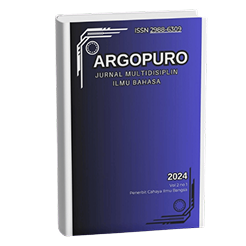TINDAK TUTUR ILOKUSI DALAM KUMPULAN LAGU KOMERING SERTA IMPLIKASINYA TERHADAP PEMBELAJARAN BAHASA
Main Article Content
Abstract
This study aims to describe the types of illocutionary speech acts found in a collection of Komering songs and their implications for Indonesian language learning. The research is motivated by the importance of preserving regional languages through local literary works, particularly songs rich in cultural values and communicative functions. This study employs a descriptive qualitative method with a pragmatic approach. The data source consists of purposively selected Komering song lyrics. Data collection techniques include documentation and observation-note-taking methods, while data analysis is conducted by identifying and classifying the forms of illocutionary speech acts based on Searle’s (1972) theory, which includes assertives, directives, expressives, commissives, and declaratives. The findings reveal that in the Komering song collection published by the YouTube channel @BHS Video Creations, there are 39 instances of illocutionary speech acts classified into five categories: assertives (10), directives (19), expressives (6), commissives (3), and declaratives (1). This indicates that Komering songs serve as entertainment media and tools for conveying emotional messages, advice, and appeals. The implication of this study for Indonesian language learning is that regional songs can be utilized as contextual teaching media for speech act material and as a means of instilling local cultural values in students.
